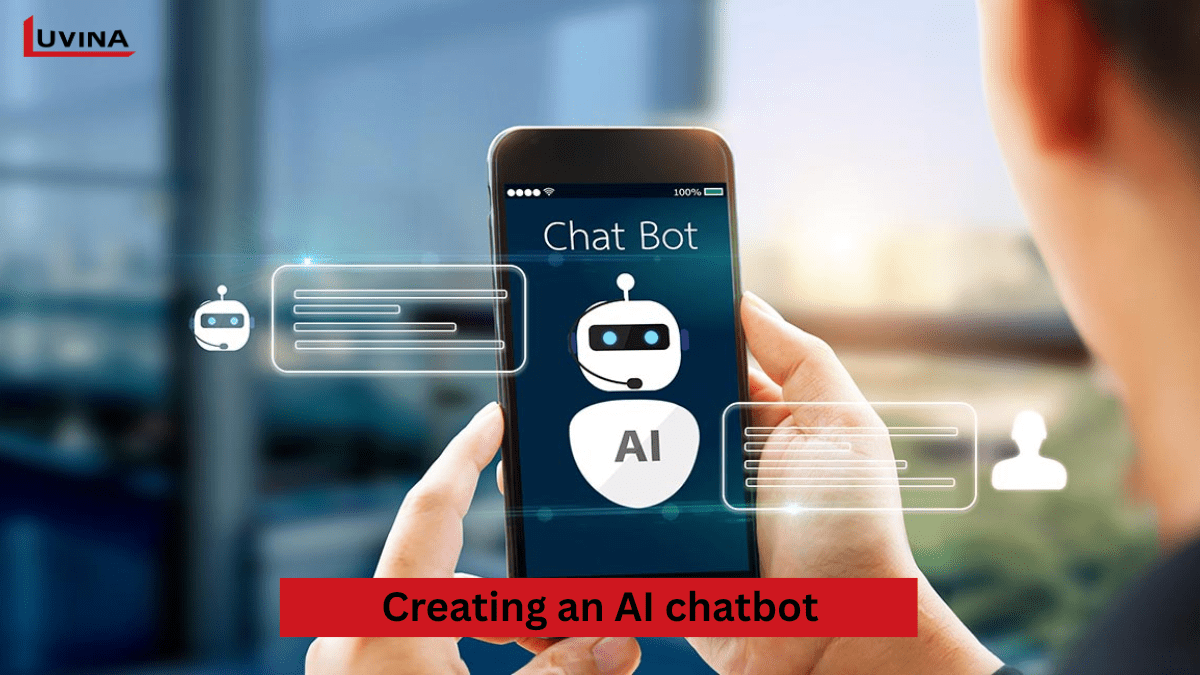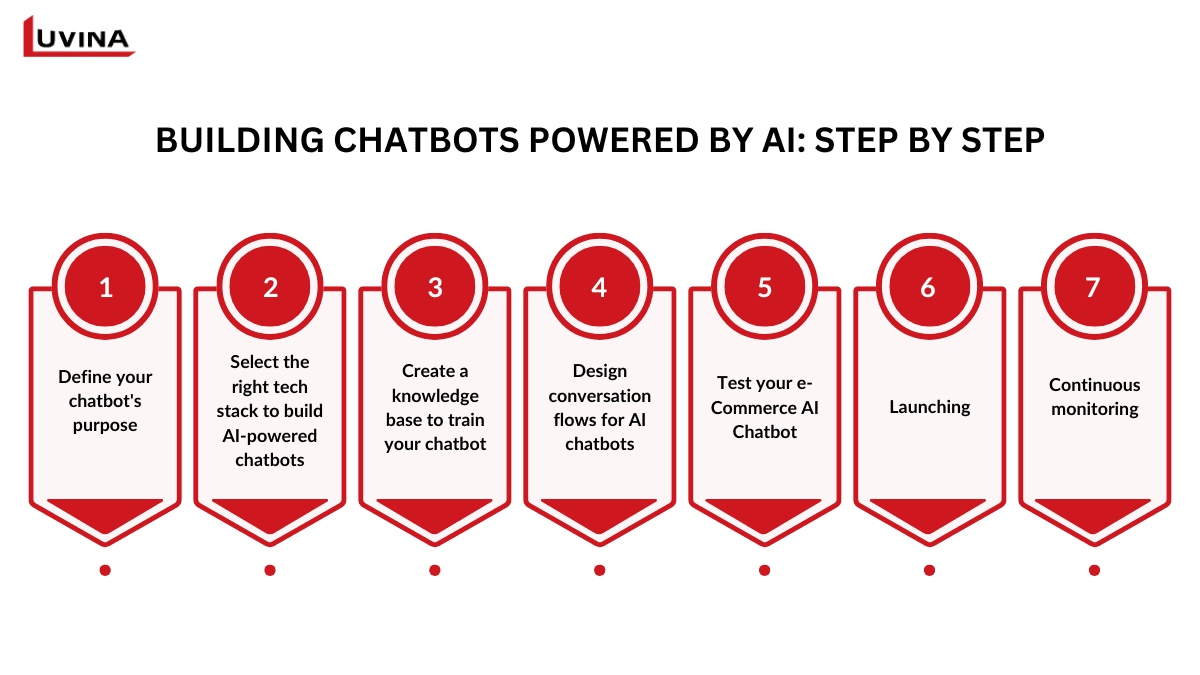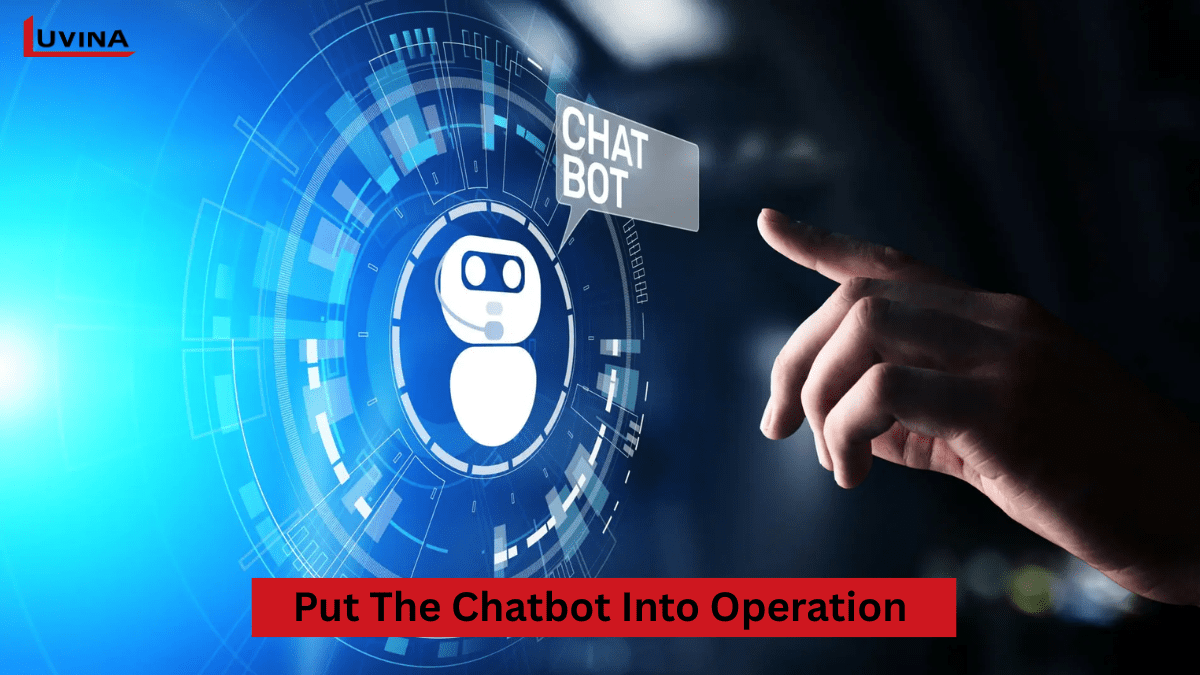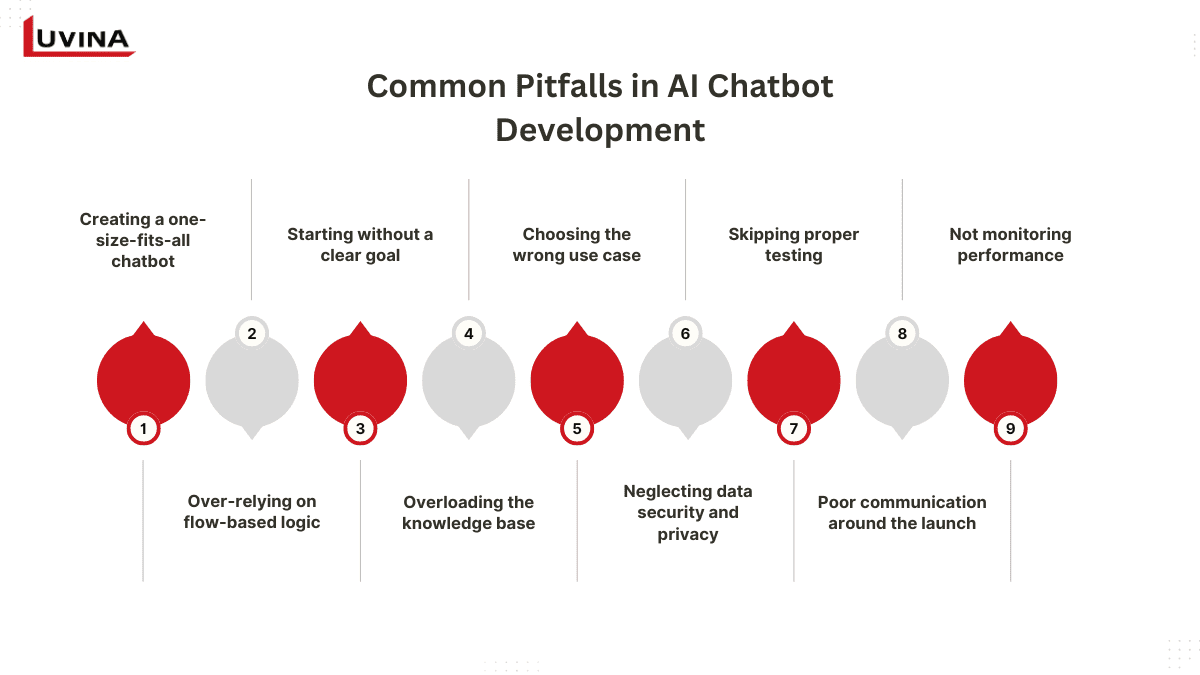By 2027, 25% of all businesses are expected to use AI-powered chatbots as their primary customer service channel (Gartner). In eCommerce, where speed and personalization define customer loyalty, AI chatbots offer a strategic advantage.
This guide helps eCommerce business leaders explore how to build your own AI eCommerce chatbots from design, development, and deployment that improve conversion rates, reduce support costs, and operate 24/7 across digital channels.
What is an AI Chatbot?
An AI chatbot is an intelligent virtual assistant that utilizes artificial intelligence tools like machine learning and natural language processing (NLP) to understand and respond to customer queries. Generally, chatbots can be rule-based or AI-based. Compared to rule-based bots, AI chatbots deliver conversational, context-aware interactions, leading to higher engagement and conversion rates.

These bots continuously learn from user interactions to deliver smarter and more relevant responses. Therefore, they provide significant value for many uses, automating customer care with product recommendations to speeding up internal processes around knowledge management or onboarding employees.
Given common user journeys and digital engagement pathways, e-commerce chatbots can be effectively used at the following major touchpoints:
- – On an e-commerce site: Support customers during the pre-purchase stage by signposting any active promotions and clarifying payment methods, delivery timing, and returns policies.
- – In messaging apps: Handle returns, monitor deliveries, supply updates, and even gather customer feedback.
- – On social media, AI chatbots may convert casual fans into devoted customers by offering prompt replies and product recommendations embedded as popups, in advertisements, or direct messages.
What You Need to Build an AI Chatbot
Building your own AI ecommerce chatbots that will add value to your business will require a carefully assembled mix of technology, data, experience, and strategy. Below is an explanation of the primary features that underlie a good AI chatbot:
- A clear business use case: It is the aspect that tells you what you need to chatbot to achieve. Does it want to lessen the workload for customer support? To also upsell with product recommendations? Or to help customers track orders and returns? A well-defined use case provides direction, purpose, and measurable success for your chatbot. e.g., product search, order tracking, upselling, post-sale support.
- High-quality training data: You’ll need clean and structured, and relevant data like Chat logs, synthetic queries, labeled intents, etc., to train your chatbot to comprehend the user intent and give useful answers.
- An appropriate tech stack: You will need a stack of technologies that can understand, process, and generate responses according to your use case.
- – NLP engine: Google Dialogflow, Amazon Lex, Microsoft Bot Framework
- – LLM integration (for advanced bots): GPT-4, Claude, etc.
- – Hosting: AWS, Azure, or GCP
- – Frontend: React/Angular for chatbot UI, or Messenger APIs
- A knowledge base: If your chatbot is going to be even a little bit useful, it needs a full knowledge base that can be easily searched. This might be internal documents, data about products, troubleshooting guides, FAQs, product catalog, CRM history, order data – anything that helps us answer users’ questions more effectively.
- A talented group of developers: To cover all your bases, you need a full, interdisciplinary team. This team usually consists of AI engineers, UI/UX designers, and backend developers.
- A multi-channel delivery plan: Consider where your users most likely will engage with your chatbot: Website widget, mobile app, WhatsApp, Facebook,etc. You should design your chatbot to work across all these platforms – and maintain a unified brand experience everywhere.
Building chatbots powered by AI: Step by step
It is very important, in any kind of development process, to follow a systematic process, whether it is simply for bettering customer service, increasing conversions, or giving 24/7 engagement. This area will guide you through the essential processes to build your own AI ecommerce chatbots.

1. Define your chatbot’s purpose
As a first question: why am I building this chatbot before I even write one line of code? From functionality and technology to where and how it’s used, the answer will influence all elements.
Your ecommerce chatbot is designed to:
- – Lower the workload for your customer service staff?
- – Automate FAQs replies?
- – Recommend goods and lead consumers along the buying process?
- – Offer post-sale help, like returns or delivery monitoring.
Being exact saves you from developing a basic chatbot without genuine value.
Also, decide where your chatbot will live. Choose channels your audience already interacts with for maximum reach & usefulness; will it be a part of your website, integrated within your mobile app, or integrated into messaging apps like WhatsApp or Facebook Messenger?
2. Select the right tech stack to build AI-powered chatbots
After you’ve determined the goals of your chatbot and channels it will be deployed on, the next important decision will be selecting a technology stack. The pieces you choose will decide HOW scalable, intelligent and flexible your chatbot will be.
Here are the core technology layers:
- Natural Language Processing (NLP) engines: NLP engines help your chatbot comprehend human language and offer easy clues for nuanced translations. There are NLP engines like Amazon Lex, Google Dialogflow, IBM Watson Assistant, and Microsoft Bot Framework that enable you to build efficient chatbots with minimal manual coding (and the possibility for more coding if you need it).
- Cloud infrastructure: Services such as AWS, Microsoft Azure, Google Cloud Platform, and IBM Cloud provide the compute power and flexibility required for NLP engines, machine learning models, and API integrations—all without having to concern yourself with the care and feeding of physical servers.
- AI and ML libraries: For a bespoke chatbot with state-of-the-art functionalities, you will have to use machine learning libraries including TensorFlow, PyTorch, Scikit-learn, and similar others. Pre-trained large language models, frameworks such as LangChain, and memory management tools such as Pinecone.io increase your bot’s intellect and situational awareness.
3. Create a knowledge base to train your chatbot
You need data to build your own AI ecommerce chatbots. The three main starting points for developing a solid knowledge base follows:

- Internal data: To start, make use of the data that your company already owns. This may be FAQs, product manuals, chat logs, CRM histories, or customer service transcripts. Actual conversations and papers will give you a context for the kind of questions your chatbot will be able to answer and push you to understand how the information should be preprocessed before being provided to the user.
- Public sets of data: If you start from scratch for want to complement the resources of your company, make use of public sets of data. You can use Kaggle, which is a platform that includes corpora of data of a given domain, for example, the Stanford Question Answering Dataset. This type of data will help your chatbot learn to answer many different types of queries by giving it a large number of various texts.
- User-written content: Generate the synthetic examples of how a user could ask the same question in a different wording to increase the flexibility of your chatbot. To improve the natural language processing (understanding) and add variety, you could make a few different versions of a return request, for instance: “I would like to return this item” or “Can I get a refund?”
4. Design conversation flows for AI chatbots
A major first step in building chatbots powered by AI is deciding on your chatbot’s user engagement strategy. Designing for adaptability will help you to create a chatbot that genuinely duplicates human conversation beyond basic logic trees:
- – Start with conversation scenarios: Define typical user objectives—product queries, order tracking, or returns, among others—and show how the chatbot should lead each engagement. This covers outlining possible ultimate objectives like purchase confirmation or feedback collection, as well as entry points, and follow-up questions.
- – Ride the wave of fast engineering and large language models: Choose a base and write some narrow, specific prompts for how to make your chatbot act.
- – Continuous learning: Your chatbot should be learning from these interactions, to keep updating its understanding of vocabulary, context, and sentiment as it interacts with more and more people, to respond appropriately even to questions it has never seen.
- – UX and integration design: Ensure the chatbot interface is inviting and intuitive. Ensure the bot is tightly integrated with your backend systems (like your CRM, product databases, etc.) via secure APIs and real-time data synchronisation, and the visual design of the bot mirrors your brand.
5. Test your e-Commerce AI Chatbot
You should be thoroughly testing your solution ahead of your launch to ensure it can stand up in any environment you intend to use it.
When you build AI-powered chatbots, these are the main areas of testing to concentrate on:
- Functional testing: Ensure your bot can perform a task, understands user inputs, and offers a contextually relevant response.
- Performance testing: Test the behavior of your chatbot for different traffic loads. It needs to be able to maintain system stability and fast response times under high-volume use.
6. Launching
When construction and testing are settled, you can introduce your chatbot to real users. From day one, you want a careful deployment plan that guarantees functionality, security, and flexibility.

Here’s the way one should tackle it:
- Test in a controlled environment: Pretend actual interactions under controlled conditions before going live.
- Run a pilot program: Release the chatbot to a small, restricted group of users to begin small. Request comments on escalation rationale, problem resolution, and conversation quality.
- Put security and compliance protections in place: You will need to encrypt data and protect API keys. Depending on the region where your consumers are, ensure your deployment complies with the data privacy laws such as GDPR, CCPA, or any applicable local law.
7. Continuous monitoring
Getting your chatbot into production status is quite a step toward achieving that, but it’s far from being the end. When building chatbots powered by AI, continuous refinement is critical to being current, actionable, and valuable.
- – Keep feeding its training data with insights from new customers, enhance prompts, and add to its response reservoir for any new problems presented.
- – Leverage analytics platforms to monitor KPIs such as resolution rates, response accuracy, engagement times, and customer satisfaction.
- – Use feedback and usage patterns to calibrate your model and its integration to continue providing a stable, helpful, and human-like experience.
AI Chatbot Development: Common Pitfalls and How to Avoid Them
Despite the best tools and intentions, it’s simple to get caught in traps that detract from your AI chatbot’s effectiveness. If you are planning to build your own AI ecommerce chatbots, then avoid these common development mistakes and find out how to prevent them from the start.

- Creating a one-size-fits-all chatbot
Most chatbots are impersonal and do not create rapport with their users. For impact, the best way to connect with people is to infuse the tone, logic, and even chatbot responses with your brand’s customer demographics and domain expertise.
Solution: Creating A chatbot that communicates the same way humans do, it feels conversational, and it should sound like your brand. Teach it with real customer data and FAQs specific to your business.
- Starting without a clear goal
To launch a chatbot that doesn’t have a clear mission is to have disjointed conversations and miss KPIs. Without a purpose, your chatbot could easily appear as a question-answering bot, not understanding visitors’ questions, or taking off on tangents.
Solution: Set targets about the kind of result you want – for instance, cutting support tickets, improving conversions, or systemising product recommendations – well before you have built it.
- Choosing the wrong use case
A chatbot is useless without a use case. The use of unfit, irrelevant, or overly ambitious use cases will compromise ROI and ease of use.
Solution: You should be considering typical chatbot use-cases like customer service, marketing automation, or internal employee tools here, which are aligned with your current business state.
- Skipping proper testing
Chatbots that are launched without robust testing often quickly fall apart under real-world usage or fail to meet users’ expectations.
Solution: Run a beta phase with chosen users. Gather feedback, track errors, and iterate flows before rolling them out in full.
- Not monitoring performance
If you don’t measure chatbot KPIs (key performance indicators) like the accuracy of response, user satisfaction, then you’ll never know whether it’s benefiting your business or slowing down your growth.
Solution: Setting up analytics to track engagement, completion rates, and fallback interactions. Use the data to improve the chatbot regularly.
- Over-relying on flow-based logic
Sites can help, but rule-based bots with rigid workflows are not prepared to answer the unexpected and to shift with the conversational tide.
Solution: Mix of flow logic and machine learning, so your chatbot learns with each interaction. It’s even more critical when you create your own AI ecommerce chatbots for shifting customer behavior.
- Overloading the knowledge base
Too much information in your chatbot’s knowledge base can overload the AI to where you get unclear responses.
Solution: Quality over quantity. Begin with minimal knowledge, and then incrementally add to the knowledge base by learning directly from users’ actions and questions.
- Neglecting data security and privacy
AI chatbots frequently handle personal information. Failing to comply with data protection protocols thus threatens with significant amounts in fines and user distrust.
Solution: Complying with laws such as GDPR, encrypting data in transit, and having a security audit/version from the very early days.
- Poor communication around the launch
A perfectly crafted chatbot will be ignored if users don’t know about the chatbot or don’t know how to use it.
Solution: Creating a communication plan. Use cross-channel promotion of the chatbot, whether that’s on social media, email, or your website. Feature tutorials or guides to help users see its potential and value.
How can Luvina help you?
At Luvina, we don’t simply discuss AI; we construct it for a reason. Having developed software for over 20 years, we will work with you to build AI-powered chatbots that genuinely meet your customer requirements and business objectives.

What makes us different?
- – End-to-end capabilities: From strategy to building, our team consists of AI engineers, app developers, and data scientists who have extensive experience in developing AI chatbots.
- – Domain: We have successful experience working with numerous e-commerce brands, building scalable, customer-oriented solutions.
- – User-centric: We get to the root of business pain points to ensure your chatbot adds value.
- – Clear process: We believe in transparent communication and flexible engagement models, so you never wonder where your project’s at.
But advancements put aside, whether it’s just to establish a simple virtual assistant or full-scale, AI-enabled integration, Luvina is here to help you transform your chatbot innovation into a new company asset.
Talk to our chatbot experts now. We’ll help you design, prototype, and launch a custom AI chatbot in 6–8 weeks. Book a free consultation now.
FAQ
Can I integrate my AI chatbot with my existing tools and systems?
Yes, AI chatbots can be integrated with your CRM, databases, websites, or third-party platforms via APIs.
How much does it cost to build an AI chatbot for my website?
It typically ranges from $5,000 for simple bots to over $150,000 for complex, custom-built solutions.
$5K–15K: basic FAQ + order tracking on Messenger.
$30K–60K: custom NLP + ecommerce integration (Magento/Shopify).
$100K+: GenAI + omnichannel + personalization + analytics dashboard.
What tools or platforms can I use to build AI-powered chatbots?
You can use platforms like Google Dialogflow, Microsoft Bot Framework, IBM Watson, Amazon Lex, or fine-tune open-source models with frameworks like LangChain or Rasa.
Which programming languages are best for building chatbots?
Python is widely used due to its ML/NLP libraries. JavaScript, Java, and C# are also common for integration and front-end logic. understanding you need, whether you’re starting from scratch or enhancing an already in-use system. Want to explore how a custom WMS could transform your warehouse? Schedule a free consultation with our team today.









Read More From Us?
Sign up for our newsletter
Read More From Us?
Sign up for our newsletter